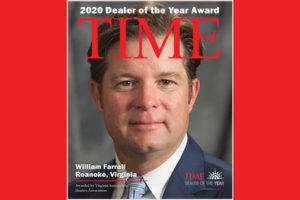By Virginia Auto Dealer Association
Some problems you don’t want: legal problems, negative publicity for your business, and the compliance issues that face all car dealerships.
Social media can give you all of these problems, despite the way it has also made a positive transformation in communication and marketing throughout the world. That’s not surprising. Something as powerful as social media has got to have a downside to it.
Why? There’s an old saying: no piece of paper is so thin that it doesn’t have two sides. Newton’s third law of physics states that every action has an equal and opposite reaction. What are the two sides of using social media?
- It’s powerful.
- Your company has to use that power responsibly.
Linking the two is not a new idea. Voltaire was the first person to talk about the connection between power and responsibility, but so did Winston Churchill, and it’s present in the kind of popular culture that reaches small children, too — after all, Peter Parker’s Uncle Ben told him about the responsibility that comes with great power, which means even a 4-year-old has some idea about how important it is to handle power responsibly.
The question is simple: how do you get the benefits and avoid the problems? In other words, how can you use social media as a free promotional tool by allowing employees to post positive news and work-related photos online without also risking negative publicity or even the public sharing of brand secrets?
The answer is equally simple. You need two workplace social media policies:
- One for all corporate social media accounts
- One for each employee’s social media accounts
The policies will guide people so they know what they can say, and (you hope) prevent them from being irresponsible online. Having guidelines for employees to use is only a first line of defense, of course, but it’s a good one. It sets the tone for how things should be said, and it makes it clear what the company values. You will save time by setting expectations in advance, and that translates into increased productivity.
Not everyone will need a copy of both policies. Corporate social media accounts are generally managed either by one person or by the applicable department (potentially, departments such as customer service, human resources, or marketing and social media). The people who post on corporate social media accounts are the ones who will need to know the rules for their particular set of responsibilities.
When your company hires any new employee, give them clear instructions, and a document containing those instructions that they can refer to later, as part of their initial training. You should also repeat the instructions periodically to people to remind them about the policy regularly. In the policy, tell them what they can and can’t talk about on their social media accounts.
The most important piece of information in any social media policy is a disclaimer that applies to everyone: the internet has made it essentially impossible to delete information. If someone posts something and then removes it a few minutes later, someone else can still take a screen shot of the post and circulate it. As a result, it is incredibly important never to post anything on any social media account without being sure it won’t cause problems later.

Implementing a social media policy might not seem important if the majority of your employees are from the baby-boom generation. They probably don’t automatically post the details of their lives. But for those who are younger, who think nothing of putting even the most trivial details of their lives online, such as what they had for dinner last night or whether they are considering the merits of two different sweaters they might want to buy, you really do need to have a conversation about which pictures and statements can be shared and which cannot. They often don’t separate their personal and professional lives, and so you need to help them know when they can share and when they need to be silent.
Consider including the following points in your general policy:
- Start with the positive. The right social media comments can help the company achieve goals. Employees can become key representatives of your business. To help them do that, teach employees how to build the company brand and drive traffic to the company’s website.
- Provide a way for people to get approval in advance if they want to say something or write something. Having a process in place ahead of time establishes responsibility in an appropriate way. That way, the company’s leaders will have an opportunity to weigh in on anything that requires some delicacy or precision in how it is said, but it also gives employees a path for being creative and proactive without getting slapped for doing something new.
- No post should include proprietary information. What’s proprietary? The information they gained from meetings or brainstorming sessions; information about prototypes; new products, including photos; photos of cash receipts, or photos of the cash register POS system.
- If you don’t want an employee to take and post pictures of your headquarters or any specific rooms within your business, say so.
- Remind them that they each have a professional brand and that they need to be careful about how they represent themselves. Can you forbid them from posting on their channels? No. You don’t have the legal authority to do that as long as they stay within that channel’s rules. However, you can explain to them the legal liability they might expose the company to, and also the possible consequences of how other people see them; brands are intangible but powerful, and once someone trashes a brand, the damage can be permanent. You can also tell them that their brand contributes to the company brand, and that if they talk about the business in unacceptable ways, they could lose their job. For example, the company can fire them for disclosing sensitive information, breaching their contract, or defaming either the company or a competitor.
- Negative comments attract other negative comments. As a result, employees should not post negative comments about the workplace, even if the comment is general and only mildly negative. (Make sure that if you close down the option of a public complaint, you provide some other way for them to work out problems. People do need an effective way to solve problems.)
- Employees should have appropriate privacy settings. LinkedIn and Twitter are both open. Facebook and Instagram can be made private. Employees need to know how private or open their accounts are, and be especially conscious of posting anything on an account that isn’t private.
- The company has a responsibility to monitor social media accounts at least passively. You can also encourage people to report threatening language. The point is not about monitoring everything employees do. Nobody wants to work for a company that does that. Instead, it’s about putting in the minimum amount of effort to find big problems early. Toward that end, there’s nothing wrong with using a tool that allows you to “listen” to social media. You can also search periodically for brand names on Instagram and Twitter.
The corporate social media policy has additional requirements you might want to add:
- Limit the number of people who have access to the company’s social media platforms. Change the passwords frequently.
- When an employee leaves the company, especially if the circumstances are negative, delete that person’s access to the company’s social media channels, and reset everyone’s social media passwords.
By educating employees about what they can and cannot say online, you accomplish two goals. You increase your company’s positive publicity, and you prevent as much negative publicity as possible.
That’s a great outcome for everyone involved.
This story appears in the 2019 Issue 4 of the Virginia Auto Dealer Magazine.







